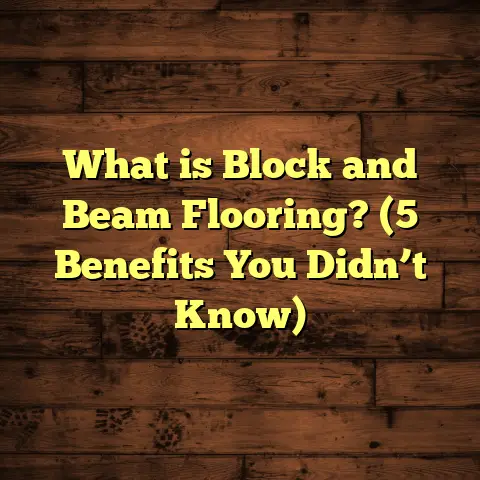What is a Floor Heater? (5 Benefits You Didn’t Know!)
Starting with a pop of color: picture a chilly winter morning. You shuffle out of bed, ready to start your day, but instead of the usual shock from cold floors, your feet land on a surface that feels like a gentle warmth spreading through your toes. That’s the magic of floor heaters working quietly beneath your feet—turning your house into a cozy haven. If you’re curious about this technology or thinking about installing one but don’t know where to start, I’ve got you covered. Let me share what I’ve learned from years of installing and living with floor heaters, the hidden perks you probably didn’t realize, and how you can make the most of this warm luxury.
What Is a Floor Heater?
At its core, a floor heater is a heating system installed beneath your floor to provide warmth. Instead of heating air like traditional radiators or forced air systems (which blow hot air around), floor heaters warm the surface you’re standing on. This method uses radiant heat to transfer warmth directly from the floor to the room.
There are two common types:
- Electric floor heating: Uses electric cables or mats installed under the floor.
- Hydronic floor heating: Circulates warm water through tubes embedded in the floor.
Both systems have pros and cons depending on your home setup, climate, budget, and flooring type.
How Does It Work?
Radiant heat works by warming objects and people directly rather than heating the air. This means warmth is distributed evenly across the floor surface and rises gently to heat the room naturally. You don’t get that blast of hot air followed by cold patches common with forced air heating.
I remember one project where I installed hydronic radiant heat in a large open-plan living room. The homeowners were amazed at how evenly warm the space felt, even near windows and doors that typically cause drafts.
Which Flooring Types Are Compatible?
You might be wondering if floor heaters can go under hardwood or carpet. The good news is they can fit under many flooring types but with some considerations:
- Tile and stone: Excellent heat conductors; they are the best match for radiant floors.
- Laminate & engineered hardwood: Work well but require attention to moisture and heat tolerance.
- Carpet: Possible but needs a low tog rating (thin carpet) so heat passes through efficiently.
- Solid hardwood: Generally not recommended because heat can cause wood expansion and contraction.
This is important because choosing compatible flooring ensures your heater works efficiently without damaging your floors.
My Journey with Floor Heaters: From Skeptic to Believer
When I first heard about radiant floor heating, I was skeptical. As a flooring contractor, I was used to traditional heating setups and thought these systems were complicated and expensive. But after installing my first electric floor heater in a client’s bathroom, I quickly realized how much difference it made.
The client was tired of cold tile floors in winter and wanted comfort without bulky radiators. Once the heater was installed, she called me back saying her mornings felt transformed: no more dreading stepping onto freezing tiles. That kind of immediate feedback hooked me on floor heaters.
Since then, I have installed dozens of systems—both electric and hydronic—and every time I notice how it changes how people live in their spaces. It’s not just about warmth; it’s about comfort, energy savings, and a quiet atmosphere.
Installation Insights: What You Need to Know
If you’re considering adding a floor heater, installation is probably top of mind. Here’s what I’ve learned from countless installs:
Electric Systems
Electric radiant heating involves laying out thin mats or cables on top of an insulated subfloor before installing your finished flooring. The mats are easy to cut and shape to fit odd spaces like bathrooms or kitchens.
- Pros: Easier and quicker installation; good for small areas or retrofits.
- Cons: Can be more expensive long-term for whole-house heating; electricity costs vary.
One tricky aspect I encountered was ensuring the cables didn’t overlap—overlapping causes overheating and potential damage. So careful planning and measurements are critical.
Hydronic Systems
Hydronic systems pump heated water through plastic tubing embedded in your concrete slab or subfloor. The water is heated by a boiler or water heater.
- Pros: More cost-effective for large areas or full-house heating; lower operating costs.
- Cons: Installation is more complex; requires plumbing expertise; longer installation time.
On one project in a new build home, we embedded hydronic tubing right into the concrete slab before pouring. This approach creates a thermal mass that stores heat efficiently but needs careful design upfront.
Preparation & Insulation
No matter which system you choose, insulation underneath your heating elements is crucial. Without it, heat escapes downward into the ground instead of warming your room—wasting energy and money.
I always recommend at least 1–2 inches of rigid foam insulation beneath heating mats or tubing. This step can improve efficiency by up to 30%.
Controls & Thermostats
A programmable thermostat designed for radiant floors helps you control temperature precisely and save energy by heating only when needed.
I often install wireless thermostats that let clients adjust settings from their phones—super convenient when you’re away or want to warm up the house before coming home.
Maintenance: Keeping Your Floor Heater Happy
One thing clients ask me all the time: how much upkeep does this system need? The good news is floor heaters are low maintenance compared to traditional HVAC systems.
For electric systems, once installed correctly they rarely have issues unless damaged physically (e.g., drilling through floors unknowingly). Regular checks on thermostat function are usually enough.
For hydronic systems, you should service your boiler or water heater regularly and inspect tubing connections occasionally for leaks.
I advise clients to keep records of installation details including wiring diagrams and tubing layouts—this info is invaluable if repairs are ever needed.
Five Benefits You Didn’t Know About Floor Heaters
Now let me share five benefits I’ve discovered through projects, research, and personal experience—benefits that often surprise those new to radiant floors.
1. Cleaner Air Means Healthier Living
Many people don’t realize that traditional forced air systems circulate dust, allergens, and pet dander throughout your home. Studies show this can worsen asthma symptoms and allergies significantly.
Radiant floor heating doesn’t rely on blowing air around. This means less dust circulation and better indoor air quality—a huge plus if you or family members suffer from respiratory issues.
A client with severe allergies told me their symptoms improved noticeably after switching to radiant heat because the system eliminated airborne irritants triggered by forced air blowers.
2. You Save More Than You Think on Energy Bills
People often assume radiant floor heating is expensive to run, but data tells a different story.
According to the U.S. Department of Energy:
- Radiant heat can reduce energy use by 10-30% compared to baseboard or forced air systems.
- Heating objects directly means less wasted energy trying to heat air first.
- Even electric systems can be cost-effective in smaller areas like bathrooms or kitchens where targeted heating reduces overall consumption.
One homeowner shared with me that after installing hydronic radiant floors in their entire home, their annual heating bill dropped by $250 despite colder winters that year—a real impact!
3. Whisper-Quiet Operation Is a Game Changer
I don’t know about you, but noisy heaters drive me crazy—especially at night or during work-from-home days. Floor heaters operate silently because they don’t use fans or moving parts.
Clients often say how much they appreciate this “invisible” comfort—no hums, rattles, or clicks interrupting their peace.
This silent warmth creates a calm environment perfect for bedrooms, offices, or meditation spaces where noise disrupts focus or sleep.
4. Radiant Heat Increases Your Home’s Value
If you’re thinking about resale value or home upgrades that stand out to buyers, radiant floor heating is one of those features that gets noticed.
Real estate data shows homes with modern comfort features like radiant floors tend to sell faster and command higher prices than similar homes without them.
One client reported that during their home sale process, several buyers specifically asked about the radiant heat system—highlighting it as a unique selling point that helped close the deal quickly.
5. Design Freedom Without Compromise
Unlike radiators or wall-mounted heaters that limit furniture placement or interior design choices, radiant floor heating is invisible under your floors.
This means you can choose any flooring style—luxury vinyl, tile, hardwood—without worrying about fitting bulky heaters into your walls or losing wall space to vents.
I once worked on a contemporary loft where stunning wide-plank flooring covered hydronic tubes beneath. The homeowners loved having completely free walls for art installations and furniture arrangements without unsightly heaters cluttering space.
Understanding Costs: How I Manage Budgeting With FloorTally
Let me be honest: estimating costs for any flooring project can be stressful and time-consuming—especially when floor heaters add complexity due to materials and labor variations.
That’s where tools like FloorTally have become invaluable for me. It helps me calculate accurate costs based on local labor rates, material prices, waste factors, and project specifics like heater type and flooring choice—all in one place.
For example:
- Inputting square footage,
- Choosing electric or hydronic systems,
- Adding flooring type (like porcelain tile or engineered wood),
- Factoring in waste materials,
- Getting detailed cost breakdowns for labor and materials,
FloorTally saves me hours of manual calculations and reduces guesswork when presenting budgets to clients.
During one recent kitchen remodel with electric radiant floors under tile, I used FloorTally to compare costs between two tile options while keeping labor consistent. It helped identify where we could cut costs without sacrificing quality—a win-win for both me and my client.
Personal Tips for Getting the Most Out of Your Floor Heater
Since I’ve seen many installs firsthand, here are some tips I usually share with clients:
- Plan your flooring early: Some floors work better with radiant heat than others.
- Don’t skimp on insulation: It pays off big time in energy savings.
- Use programmable thermostats: They prevent wasting energy when rooms aren’t occupied.
- Avoid covering heated floors with thick rugs: This blocks heat transfer.
- Keep documentation handy: Know where heaters are located before drilling or nailing anything into floors.
- Consider professional installation: While DIY kits exist, mistakes can be costly.
Real-Life Case Study: Hydronic Heating in a Cold Climate Home
Here’s a story from one of my projects that illustrates how floor heaters transformed a home:
A family living in upstate New York contacted me because their old forced-air furnace wasn’t cutting it during brutal winters. They wanted a more efficient system that provided consistent warmth without noisy vents or dry air issues.
We decided on hydronic radiant floor heating embedded in a new concrete slab during their home addition renovation. The system connected to a high-efficiency boiler running on natural gas.
After installation:
- Their energy bills dropped by nearly 20% compared to previous winters.
- They noticed no cold spots near windows despite single-pane glass.
- The quiet warmth improved sleep quality—no more furnace blasts waking kids at night.
- The family enjoyed walking barefoot all year round without cold toes—a simple pleasure they hadn’t expected but loved.
This case shows how modern radiant heat can blend comfort with cost savings effectively even in tough climates.
Common Questions About Floor Heaters
Q: Will radiant floor heating dry out the air?
A: No. Unlike forced-air systems that blow warm dry air around, radiant heat warms surfaces without reducing humidity levels. This helps maintain comfortable indoor air quality naturally.
Q: Can I install floor heating myself?
A: For small electric kits in bathrooms or kitchens, yes—if you’re comfortable with electrical work and follow instructions carefully. For whole-home hydronic systems or complex installs, hiring professionals is recommended to ensure safety and efficiency.
Q: How long does installation take?
A: Electric mats can be installed in a day for small rooms; hydronic systems take longer due to tubing layout and connection to boilers—usually several days depending on project size.
Q: Does radiant heat work with all home layouts?
A: Almost all layouts can accommodate radiant floors but older homes may require subfloor modifications or additional insulation for best results.
Q: Is radiant floor heating eco-friendly?
A: Yes! Radiant heating uses less energy overall because it heats directly rather than wasting energy warming air first. Hydronic systems powered by renewable energy sources (like solar water heaters) further reduce carbon footprints.
Wrapping Up What You Should Know About Floor Heaters
If you’ve made it this far, you’re probably weighing whether floor heaters fit your lifestyle and home needs. Here’s what I want you to take away:
- Floor heaters provide even, comfortable warmth that changes how you feel indoors.
- They improve indoor air quality by reducing dust circulation.
- They save money over time through energy efficiency.
- Operation is quiet compared to noisy forced-air systems.
- They add value and design flexibility without cluttering space.
- Proper installation and insulation are key for performance.
- Tools like FloorTally help manage costs effectively so there are no surprises.
- Maintenance is minimal but regular checks protect your investment.
- Both electric and hydronic options exist depending on budget and project scale.
If you’re considering making this upgrade yourself or working with contractors, ask lots of questions about materials compatibility, warranties, and energy savings projections based on your specific home environment.
I hope sharing my experiences and insights helps you feel confident exploring floor heating options for your next project. If you want me to dive deeper into specifics like installation step-by-step guides or budgeting breakdowns using tools like FloorTally, just let me know!





